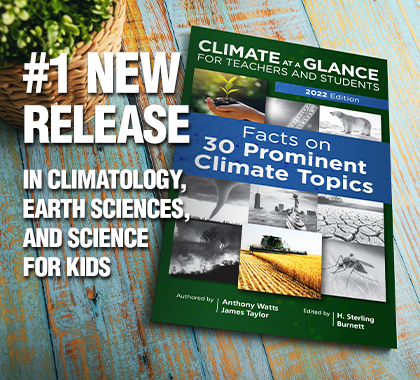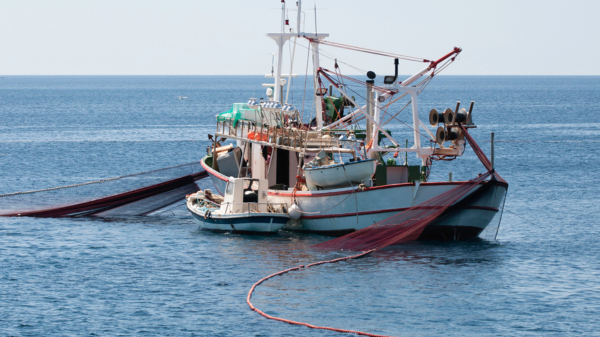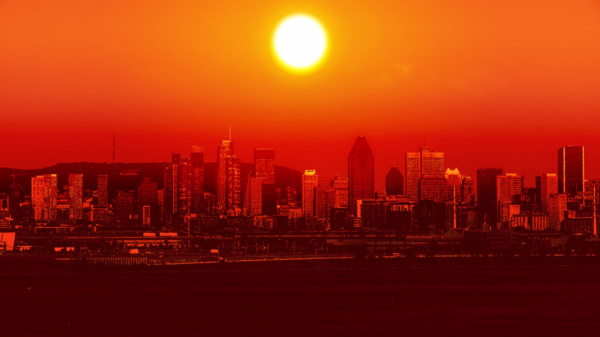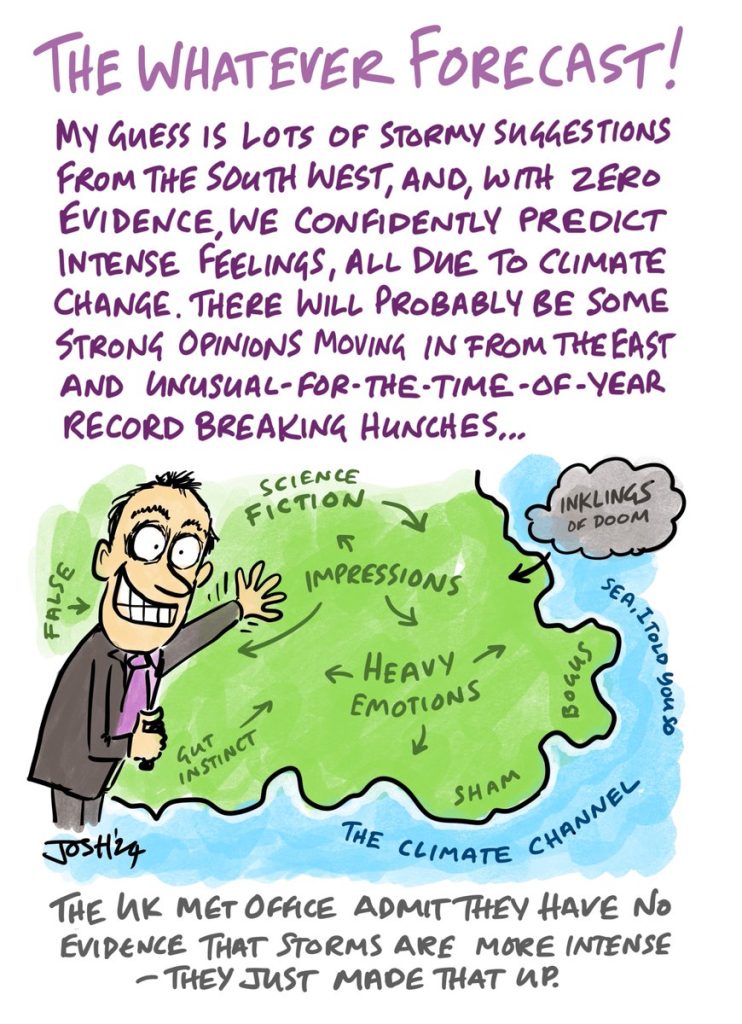YOU SHOULD SUBSCRIBE TO CLIMATE CHANGE WEEKLY.
IN THIS ISSUE:
- A Proposal to Fix Science Education
- Video of the Week: Carbon Tax Fight! Elon Musk vs. Steve Milloy of JunkScience.com
- U.N. Says Cereal Crops Set Record, Again, in 2023
- Bottom Trawling Contributes Millions of Tons of Atmospheric Carbon Dioxide—New Research
- New Factor in Urban Warming Discovered
- Podcast of the Week: The SEC Lacks Authority to Mandate Climate Concern (Guest: Stone Washington)
- Climate Comedy
- Recommended Sites
Watch ALL the Presentations by the ALL-STARS of Climate Realism at the Archive of Heartland’s 15 Climate Conferences
A Proposal to Fix Science Education

Editor’s Note: This week’s lead essay is a guest post from long-time collaborator, friend, and energy and science analyst John Droz. I have referred to John’s work before and even cited him at length on climate science. Even if climate science hadn’t devolved largely into a den of knaves and “yes men/women” more concerned with influence peddling, funding, and career advancement than the pursuit of knowledge and truth, John’s proposal below would be valuable. Malfeasance and sloppiness have become apparent in other scientific disciplines as well, in recent years, like medical science and physics. Any bracketed material in the essay below is mine.
The Most Powerful Education Idea Ever?
A Single New High School Science Class Would Be Revolutionary
By John Droz Jr.
Before I reveal a unique and powerful solution to what is ostensibly our most serious societal peril, we need to be clear about what the peril is. This is a brief outline:
a) The worst current problem in US K-12 schools (by far), is WHAT our children are being taught—i.e., what is in (or missing from) the curriculum.
b) In my opinion, the part of the curriculum that has been most extensively corrupted is the subject area of Science. This is due to 49 ± states fully (or mostly) adopting the progressive Next Generation Science Standards (NGSS), which is a frontal assault on traditional science (e.g., they quietly extracted the scientific method, and are subverting critical thinking). See this Report for details.
c) Although you likely haven’t heard it before, this is arguably the most significant attack on America. Every year this results in some 3 million propagandized high school graduates, who shortly become voting citizens. This is unsustainable!
d) [No person or organization] (parents, teachers, legislators, State Boards of Education, scientists, conservative organizations, etc.) [has comprehensively examined and] expos[ed] the NGSS for what it is.
e) Likewise, no one has come up with a realistic alternative to the NGSS, or a practical solution to fix the NGSS—until today!
Now that you have a glimpse of the profound consequences of this major unaddressed societal problem, let’s proceed to a unique and powerful solution.
In most U.S. schools, science offerings in K-8 are general and rudimentary. In High School (HS), they get more specific and more advanced. For example, in HS there is typically one year each of such classes as biology, geology, chemistry, and physics. (Sometimes there are quasi-fluff options like environmental science.)
The assumption is that after eight years of general science, students are prepared for (and interested in) more depth in the traditional sciences. [Note: Based on current NGSS-oriented curricula, the accuracy of that assumption is highly questionable.]
What’s proposed here is that a mandatory “overview” Science [Purpose and Methods] class be given to all 9th graders. An appropriate title might be: Real Science 101—but be creative with the name!
[It should be] mandatory … because science is now an essential element of our existence, so every child needs to be taught some in-depth science basics—which parents assume are being covered. However, due to the proliferation of the NGSS, almost all of the examples below are superficially treated, mistreated, ignored, [or in some instances, the exact opposite is being taught]:-
- Critical Thinking (Properly defining, understanding, and teaching it. This includes appreciating the numerous, profound benefits of being a critical thinker.)
- Linear vs. Lateral thinking (there are significant merits for both). [Linnear thinking is a systematic and analytical thought process that follows a known step-by-step progression similar to a straight line, whereas lateral thinking approaches problems by using reasoning that is disruptive or not immediately obvious, using indirect and creative methods to think outside the box.]
- Why [and how] is science under assault? (science is a gatekeeper, science is respected, etc.)
- Definition of science (Science is a Process)
- History of the Scientific Method (4,000± years of a successful process)
- The four key elements of a Scientific Assessment (Objective, Comprehensive, Empirical, and Transparent)
- Hypothesis vs. Theory (explaining the different levels of Scientific certainty)
- Scientific responsibility (Is it the proponent’s obligation to prove their claim, or is it the obligation of skeptics to disprove it?)
-
- Science and Public Relations (Is being right enough to win the day?)
- Science and Public Policy (How should the two relate?)
- Real Science vs. political science (not even remotely similar)
- Consensus (not a Scientific procedure, but rather a political aspiration)
- Peer Review (a good idea that has been co-opted)
- Statistics (the good, bad, and the ugly of probabilities, etc.)
- Data (there’s data and then there’s data [how to assess the quality])
- Correlation vs. Causality (What is the relationship between the two?)
- Computer Models and projections (benefits and substantial weaknesses)
- Science vs. Scientists (Are studies by scientists, Scientific?)
- Scientists and Relativism (Does the end objective justify the means?)
- Post-Normal Science (Are some technical issues beyond the ability of Science to assess?)
- Normative Science (agenda-driven scientists rarely produce real Science)
- Technical terminology (conveying hidden messages with carefully chosen words)
- The Precautionary Principle (Is this scientific or ideological?)
- Intuition vs. Science (making assumptions can easily lead to unscientific conclusions)
- Scientists vs. Engineers (how they differ in objectives, methodology, etc.)
- The Mantle of Science (How should bogus claims about Science be exposed?)
- Science and the Media (journalism vs. advocacy)
- Artificial Intelligence (our best friend and our worst enemy)
- Social Emotional Learning (how Critical Thinking can achieve SEL objectives)
- Science and Religion (Can Science prove, or disprove, the existence of God?)
- [Hard Science vs. Social Science]
After taking such a class:
a) [S]tudents would be better prepared to encounter science (and pseudoscience) [as it is practiced and portrayed in the real world], even if they never took another science class,
b) [S]tudents would perform better on state and national science tests.
c) Because (if done right) this would likely be perceived to be [among the] most interesting high school course[s] offered (in all subject areas), a higher percentage of students would become STEM-interested.
d) STEM students would be MUCH better prepared to subsequently take traditional science classes in high school and college.
For the above four significant reasons, this should become a state-required class, built into each state’s science standards.
Note: All of the states’ current science standards that are NGSS-based would then need to be reviewed (which was already essential to critically do anyway), as some of Real Science 101 conflicts with NGSS.
The bottom line is that requiring this one class would result in extraordinary benefits to students, [to the practice of science itself], and [as a result, to civilization and society as a whole].
- John Droz is a physicist, citizen advocate, and patriot who founded the Alliance for Wise Energy Decisions.
Source: Critically Thinking
Get your Copy at Amazon TODAY!

Video of the Week
Elon Musk recently put out a video endorsing the climate hoax and a global “carbon tax.” Watch the video with climate hoax slayer Steve Milloy — Heartland Institute board member and founder/publisher of JunkScience.com — as he comments on where Musk went wrong. Milloy then challenges Musk to a debate over the carbon tax. Watch for more to come on this channel from Steve Milloy.
Read the brutal truth about how battery production for electric vehicles cause immense environmental destruction and human tragedy.
U.N. Says Cereal Crops Set Record, Again, in 2023

The U.N. Food and Agriculture Organization was created with the goal of defeating hunger, improving nutrition, and increasing food security. As part of that mission, it gathers data on and monitors crop production globally. Its most updated records, discussed in its Cereal Supply and Demand Brief, show that the world’s cereal crops, the staple of food production globally, continue to set new records even has the Earth modestly warms.
Cereal grains are grown in greater quantities and provide more food energy globally than any other type of crop, with rice, wheat, and maize (corn), accounting for three quarters of all cereal grain production. The FAO’s Brief reports:
FAO’s forecast for world cereal production in 2023 has been revised upward by 13.2 million tonnes (0.5 percent) this month and is set to reach a record high of 2836 million tonnes. This represents a 1.2 percent (33.3 million tonnes) increase from the 2022 level. The revision is primarily the result of better-than-previously envisaged maize outputs in several key producing countries, while more modest upward revisions were made to the global barley and wheat production forecasts.
The global coarse grain output is pegged at an all-time high of 1523 million tonnes, following a 12-million-tonne upward adjustment this month. The bulk of the revision reflects new official data from Canada, China (mainland), Türkiye and the United States of America, where a combination of higher yields and larger harvested areas than previously expected has led to higher maize production estimates. …, FAO’s forecast of world rice production in 2023/24 now stands at 524.6 million tonnes (milled basis), marginally lower than the December forecast but still 0.6 percent above the 2022/23 outcome. (see the graph, below)

As has been discussed in more than 200 articles on Climate Realism, what is true of global cereal production is true for most crops—like fruits, legumes, tubers, and vegetables—in most countries around the world. Yields have set records repeatedly during the recent period of climate change, food security has increased, and hunger and malnutrition have fallen.
Agronomy and botany explain why crop production and yields have increased amidst global warming, and the same sciences explain why the world should likely expect crop production gains to continue. Modest warming has brought slightly higher rainfall totals, and a modestly longer growing season with fewer crop-killing late-season frosts. In addition, crops are benefitting from higher carbon dioxide levels in the atmosphere, which any greenhouse operator will tell you is plant fertilizer, contributing to plants growing larger, faster, and using water more efficiently.
Source: Not a Lot of People Know That; U.N. Food and Agriculture Organization
Heartland’s Must-read Climate Sites



Bottom Trawling Contributes Millions of Tons of Atmospheric Carbon Dioxide

A new study in published in the journal Frontiers of Science discusses a previously little discussed and understood source of carbon dioxide being emitted into the atmosphere from the world’s oceans: CO2 stirred up from the ocean floor due to bottom trawling for sea food.
Carbon dioxide has accumulated on the ocean floors for millennia. Trawling disturbs the ocean floor, including the carbon dioxide stored there.
Trawling the seafloor disturbs carbon that took millennia to accumulate, but the fate of that carbon and its impact on climate and ecosystems remains unknown. The study compared data on bottom trawling carried out globally between 1996-2020, as inferred from satellites, and run through sophisticated carbon cycle models to estimate how much of the carbon dioxide stirred up through trawling ultimately makes it into the atmosphere and over what time period. They found:
that 55-60% of trawling-induced aqueous CO2 is released to the atmosphere over 7-9 years. Using recent estimates of bottom trawling’s impact on sedimentary carbon, we found that between 1996-2020 trawling could have released, at the global scale, up to 0.34-0.37 Pg CO2 yr-1 to the atmosphere, and locally altered water pH in some semi-enclosed and heavy trawled seas.
“We have long known that dragging heavy fishing nets—some as large as ten 747 jets—across the ocean floor destroys sea life and habitats,” lead author of the study Trisha Atwood, Ph.D., of Utah State University and National Geographic Pristine Seas, told SciTechDaily. “Only recently, we have discovered that bottom trawling also unleashes plumes of carbon, which otherwise would be safely stored for millennia in the ocean floor.
“Our study is the very first to show that over half the carbon released by bottom trawling eventually escapes into the atmosphere as carbon dioxide over the span of about ten years, contributing to global warming,” Atwood continued. “Much like destroying forests, scraping up the seafloor causes irreparable harm to the climate, society, and wildlife.”
Importantly, if this research is correct and bottom trawling releases as much as 370 million metric tons of carbon dioxide annually into the atmosphere, then a percentage of measured atmospheric carbon dioxide is actually coming from a source unaccounted for in climate models. That means the amount from other sources contributing to the rise in CO2 is less than previously assigned. Ocean outgassing from trawling is just one more factor that climate models fail to account for.
Sources: SciTechDaily; Frontiers in Marine Science
New Factor in Urban Warming Discovered

New research published in the journal Remote Sensing of Environment suggests that a previously unaccounted for factor is contributing to measured warming in urban areas: changes in the albedo of those regions due to increased greening.
This study confirms, first, what many other studies have found—that CO2 fertilization is contributing to greening of the earth. According to their measurements, using high-resolution surface albedo datasets generated from Landsat for 3,037 global major cities, rising CO2 has enhanced the greening trend in “72.6 percent of cities across the world since 1985, accelerating to 89.2% since 2001.”
The authors find that this greening has lowered the albedo of these cities and urban areas. The greening has resulted from two causes: landscaping and tree planting; and warming and CO2-enhanced vegetation growth.
Models that account for the changing albedo from urban greening better reflect urban warming than models that work in imaginary worlds where CO2 and other greenhouse gases are the only forcing factors and even clouds don’t exist.
This research suggests that the greening-induced albedo effect:
amount[s] to a +2.76 W/m² increase in solar radiation reaching the surface from 1986-2020.
In contrast, the clear-sky-only trend from CO2 surface forcing only amounts to 0.2 W/m² per decade (22 ppm), or 0.02 W/m² per year, in the 21st century.
Thus, the positive radiative imbalance from the declining trend in albedo explains urban warming far better than an enhanced greenhouse effect from a clear-sky-only CO2 radiative forcing.
Urban greening, just yet another factor climate models, and the scientists proclaiming their accuracy, fail to account for when discussing the causes and supposed dangers of increasing temperatures.
Sources: No Tricks Zone; Remote Sensing of the Environment
Podcast of the Week
The Securities and Exchange Commission is trying to become a climate regulator. It has proposed forcing companies under its regulatory purview, and even those outside of its direct authority, to take climate change seriously. The proposals would force SEC regulated companies, and those in their supply chains, to report how climate change will effect their operations, their emissions, and how they are responding to shifts in weather.
Subscribe to the Environment & Climate News podcast on Apple Podcasts, iHeart, Spotify or wherever you get your podcasts. And be sure to leave a positive review!
Climate Comedy
via Cartoons by Josh




























